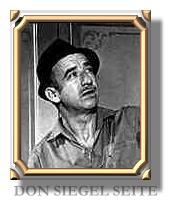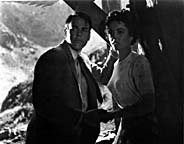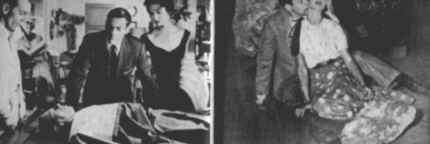 |

(Invasion of the Body Snatchers)
|
 |
ANALYSE |
|---|
 |

(Invasion of the Body Snatchers)
|
 |
ANALYSE |
|---|
Miles Bennel, Arzt in der kleinen kalifornischen Gemeinde
Santa
Mira, hat immer mehr Patienten, die behaupten, daß ihre Männer
und Frauen nicht mehr sie selbst zu sein scheinen. Sie
 sehen
aus wie früher, aber erscheinen kalt, distanziert, seltsam unvertraut.
Bennel macht eine schockierende Entdeckung: Aliens sind dabei, Santa Mira
zu erobern, Einwohner für Einwohner. Der Ort ist infiziert mit
Samenhülsen, die Wesen enthalten, die die Identität eines jeden
Bewohners annehmen können. Wenn die Leute von Santa Mira zu Bett gehen,
nehmen die Hülsenwesen erst ihre Gestalt an und zerstören dann
die Körper. Ihr einziges Ziel ist die Vermehrung ihrer selbst. Der Film
basiert auf dem Roman von Jack Finney, der von Philip Kaufmann 1978 und von
Abel Ferrara 1993 (in gewisser Weise auch von Robert Rodriguez als 'The Faculty'
1998) erneut verfilmt
wurde. sehen
aus wie früher, aber erscheinen kalt, distanziert, seltsam unvertraut.
Bennel macht eine schockierende Entdeckung: Aliens sind dabei, Santa Mira
zu erobern, Einwohner für Einwohner. Der Ort ist infiziert mit
Samenhülsen, die Wesen enthalten, die die Identität eines jeden
Bewohners annehmen können. Wenn die Leute von Santa Mira zu Bett gehen,
nehmen die Hülsenwesen erst ihre Gestalt an und zerstören dann
die Körper. Ihr einziges Ziel ist die Vermehrung ihrer selbst. Der Film
basiert auf dem Roman von Jack Finney, der von Philip Kaufmann 1978 und von
Abel Ferrara 1993 (in gewisser Weise auch von Robert Rodriguez als 'The Faculty'
1998) erneut verfilmt
wurde.
|
| Cast
Kevin McCarthy Dana Wynter Larry Gates King Donovan Carolyn Jones Whit Bissell Ralph Dumke Tom Fadden Virginia Christine Everett Glass Dabbs Greer Richard Deacon Beatrice Maude Jean Andren Pat O'Malley Kenneth Patterson Sam Peckinpah Guy Rennie Don Siegel Eileen Stevens Harry Vejar Guy Way Jean Willes Bobby Clark |
.
- Dr. Miles Bennel - Becky Driscoll - Dr. Dan Kauffmann - Jack - Theodore - Dr. Hill - Nick - Uncle Ira Lentz - Wilma Lentz - Pursey - Mac - Dr. Harvey Bassett - Grandma - Aunt Eleda Lentz - Man Carrying Baggage - Driscoll - Charlie (meter reader) - Proprietor . - Mrs. Grimaldi - With Man Carrying Baggage - Sam Janzek - Sally - Jimmy Grimaldi - Mann am Tunnel |
Crew:
Don Siegel Walter Wanger Sam Peckinpah Carmen Dragon Robert S. Eisen Edward Haworth Joseph Kish . Emile LaVigne Milt Rice Ralph Butler Allen K. Wood
|
.
- Regie - Produzent - Drehbuch . - Kamera - Musik/Komponist - Schnitt - Production Designer - Production Designer . - Makeup - Special Effects - Sound/Sound Designer - Production Manager |
| "We
spent very little on special effects, less than 15,000 dollars, with which
our production designer, Ted haworth, worked miracles. We concentrated on
the story and the acting, instead of spending thousands on special effects
and sticking wooden actors on the screen. This is probably my best film because I hide behind a facade of bad scripts, telling stories of no import and I felt that this was a very important story. I think that the world is populated by pods and I wanted to show them. I think so many people have no feeling about cultural things, no feeling of pain, of sorrow. I wanted to get it over and I didn't know of a better way to get it over than in this particular film. I thought I shot it very imaginatively. And I was encouraged all the time by Wanger. The film was nearly ruined by those in charge at Allied Artists who added a preface and ending that I don't like. The political reference to Senator McCarthy and totalitarianism was inescapable but I tried not to emphasise it because I feel that motion pictures are primarily to entertain and I did not want to preach." (Lovell Interviews, S. 54) -------------------------------------------------------------------------------------------------- Wir haben sehr wenig für Special Effects ausgegeben, weniger als 15.000 Dollar, mit denen unser Production Designer, Ted Haworth, wahre Wunder gewirkt hat. Wir haben uns auf die Geschichte und die Schauspieler konzentriert, statt Tausende für Spezialeffekte auszugeben und dafür hölzerne Darsteller vor die Kamera zu stellen. Wahrscheinlich ist dies mein bester Film, denn gewöhnlich verstecke ich mich hinter der Fassade von schlechten Drehbüchern, erzähle Geschichten ohne Bedeutung und hier wußte ich, das ist eine wichtige Geschichte. Ich glaube daß die Welt von 'Hülsenwesen' bewohnt wird und ich wollte sie zeigen. So viele Menschen haben keine Ahnung von kulturellen Dingen, kennen das Gefühl von Schmerz, von Sorge überhaupt nicht. Ich glaube, daß der Film der Fantasie viel bietet. Und Wanger hat mich stets ermutigt. Die Leute bei Allied Artist haben den Film fast zerstört, indem sie einen Prolog und einen Epilog hinzufügten, die mir überhaupt nicht gefallen. Der politische Bezug zu Senator McCarthy und Totalitarismus drängte sich natürlich auf, aber ich habe versucht, ihn nicht zu sehr zu betonen, weil ich der Meinung bin, Filme sollen in erster Linie unterhalten und predigen wollte ich nicht. ---------------------------------------------------------------------------------------------------- |
| "Santa Mira The picture begins with Dr
Miles Bennell arriving in the small town of Santa Mira
(-zurück-),
a suburb of Los Angeles, by train. The name of the town we used is Sierra
Madre, which we picked because it fit the story and worked out very well.
We shot in the city and its environs for about a week. We also used Bronson
Canyon, with its tunnels, in the Hollywood Hills.(...) Auftritt Sam Peckinpah: (Miles and Becky) lean against the wall of the tunnel, Miles unable to take another step. He sets Becky on her feet. (...) The Silhouette of a man (Sam Peckinpah) approaches the tunnel's entrance. He shouts back to the crowd that they could be inside, and his cry echoes and re-echoes throughout the tunnel. Keine Tricks: No second unit was used here, or anywhere else in the picture. There was no process in the picture: every shot was authentic. The shots of Kevin's final scene were filmed just before dawn, and Kevin was in real danger, considering that he was at the breaking point of complete exhaustion. Normalität: My idea, which Wanger seconded strongly, was to confront the idea of pods taking over the word als normally and naturally as possible (...) We therefore had the various characters in the picture, when first learning about the pods, pay little or no attention to this silly rumour. But when they were suddenly face to face with the monstrous horror, their reaction was startlingly frightening, as it would be in real life. Humor: Allied Artist, bursting at the seams with pods, took Wanger's and my final cut and edited out all the humour. In their hallowed words, 'Horror films are horror films and there's no room for humour. Rahmenerzählung: The studio also insisted on a prologue and an epilogue. Wanger was very much against this, as was I. however, he begged me to shoot it to protect the film, and I reluctantly consented (...). Oddly enough, in Europe and in the 'underground' in America, Invasion of the Body Snatchers was shown with the prologue and the epilogue edited out. Like this, it was known as 'the Siegel version'." Don Siegel: A Siegel film. S. 178-185 ---------------------------------------------------------------------------------------------------- |
| "Wirklich ist die ungeheure 'Normalität' das
eigentlich Entsetzende in diesem Film. (...) Wenn das Phantastische wirksam
ist nur als die Kraft, die in das normale Leben hereinbricht, und ein guter
phantastischer Film deshalb davon lebt, daß er zunächst einmal
ein sehr präzises Bild der normalen Wirlichkeit gibt, dann entstammt
die spezifische Paranoia in Siegels Film dem Umstand, daß das Phantastische
nichts weiter ist als die potenzierte Normalität."
Georg Seeßlen. Kino des Utopischen. Geschichte und Mythologie des Science-Fiction-Films. Reinbek b.H. 1980. S. 159 |
| Frage: Wie
war es möglich, unter den Augen der strengen McCarthy-Doktrin eine so
durchsichtige Parabel auf den McCarthyismus durchzusetzen? Siegel: Sie sehen das zu problematisch. Sicher, die Geschichte von den pflanzlichen Lebewesen, die die Welt erobern und als seelenlose Kopien friedlicher Bürger Böses verbreiten, kann verständlich machen, was ich gemeint habe. Doch die Studiobosse sind im Grunde sehr naiv, und dieser Mister Siegel war 1956 für die Amerikaner ein völlig unbeschriebenes Blatt - etwa wie heute Stephen King, ein Mann des Trivialen, der Fantasy, der Fiction. Denkt man da an die Kommunistenjäger McCarthy, Nixon oder Reagan? Nein, man denkt an Action- und Horror-Fiction und einen Mann, der damit Geld verdient. Interview mit Heiko R. Blum. epd Film 6/1991. S. 23 |
| Art director Ted Haworth, who had designed Alfred
Hitchcock's Strangers on a Train and I Confess, began busily scouting locations
on the first week of January, 1955. To represent the fictitious
Santa Mira, he first considered Mill Valley (located
to the north of San Francisco) which had been Finney's model for the doomed
town. He and Siegel decided on Sierra Madre, a beautiful, hill-laden San
Gabriel Valley town just north of Pasadena. Principal photography commenced
on March 23, with five days of exteriors in Sierra Madre. A few other location
shots were captured in the Los Angeles area, after which interiors were shot
at the studio. On April 7, the film's long climactic chase, which had begun
in Sierra Madre, was continued on Mulholland Drive - a thoroughfare which
snakes over the Santa Monica Mountains from Hollywood to the Pacific - and
in the granite crags and caves of Brush Quarry in Bronson Canyon, a part
of the parks administration in
Hollywood.(...)(-zurück-)
The picture's principal shoot wrapped on April 18, after 10 days of rehearsal and 19 days of photography.Postproduction would prove to be much more time-consuming. For a month, Siegel toiled with the studio editorial supervisor, Richard Heermance, to create a rough cut. (...) Wanger was horrified to learn that the Allied execs opted to release the picture in SuperScope, an anamorphic widescreen process introduced by RKO Radio in 1954. It differed from CinemaScope in that the photography was done with normal lenses; the images were squeezed at the printing stage rather than in the camera. Wanger argued that a duped image would not do justice to Dana Wynter's beauty, that the carefully wrought compositions would be ruined, and that the widescreen effect would make the picture resemble recent inferior anamorphic sci-fi pictures Again, he was overruled - widescreen was considered a "must" at the time due to the perceived competition with television for audiences. Incidentally, Wanger was dead right on all counts. The damage caused by this last-minute decision can hardly be exaggerated. Fredericks had composed the picture for the 1.33:1 ratio, and the image-chopping required to obtain the 2:1 ratio needed for SuperScope not only destroyed the compositions, but left important details out of the frame. In addition, the images became grainier when the remaining frame was blown up to fill the wide screens. Only a very good movie could survive such butchery; somehow, Body Snatchers did. (...) Wanger wanted to add a prologue and epilogue that emphasized the reality of the film, and linked it to actual struggles with totalitarianism in America and abroad. He thought of opening with a quotation from Winston Churchill, but was refused permission. His attempts to get Orson Welles to do the prologue failed as well. The producer's next notion was to feature a famous news analyst interviewing Miles in his hospital bed as an opening lead-in. After unsuccessfully approaching several noted broadcast journalists - Edward R. Murrow, Lowell Thomas, Quentin Reynolds, and John Cameron Swayze - he gave up on the idea. Studio executives agreed with Wanger about the necessity of a framing prologue and epilogue, and brought Mainwaring back to write them. George Turner: A Case For Insomnia. In: American Cinematographer. März 1997 |
|
| ---allmovie---imdb---lexikon des internationalen films--- |